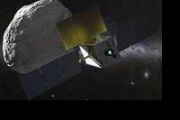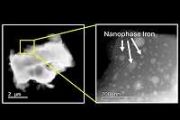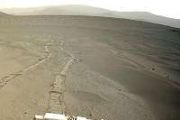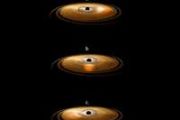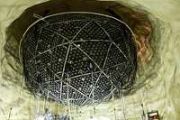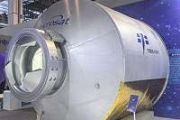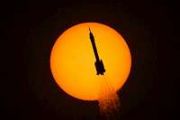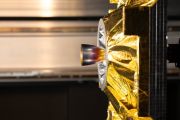
Copernical Team
NASA launches mini satellite in bid to return to the Moon
 NASA blasted a nanosatellite barely bigger than a microwave oven into outer space Tuesday, part of a landmark mission to return humans to the Moon.
A rocket carrying the tiny CAPSTONE module successfully launched from New Zealand's eastern Mahia Peninsula to a deafening blast and a wash of fiery propulsion.
"We have liftoff!" NASA said in a statement shortly after the 09:55 GMT launch, d
NASA blasted a nanosatellite barely bigger than a microwave oven into outer space Tuesday, part of a landmark mission to return humans to the Moon.
A rocket carrying the tiny CAPSTONE module successfully launched from New Zealand's eastern Mahia Peninsula to a deafening blast and a wash of fiery propulsion.
"We have liftoff!" NASA said in a statement shortly after the 09:55 GMT launch, d Rocket Lab launches CAPSTONE microsat on NASA lunar mission
 Rocket Lab USA, Inc. (Nasdaq: RKLB) has successfully launched CAPSTONE, a microwave-oven-sized satellite designed to test a new orbit around the Moon for NASA. CAPSTONE was launched at 09:55 UTC, June 28 on an Electron rocket from Rocket Lab Launch Complex 1 in Mahia, New Zealand. The mission was Rocket Lab's 27th Electron launch.
Designed and built by Tyvak Nano-Satellite Systems, a Terra
Rocket Lab USA, Inc. (Nasdaq: RKLB) has successfully launched CAPSTONE, a microwave-oven-sized satellite designed to test a new orbit around the Moon for NASA. CAPSTONE was launched at 09:55 UTC, June 28 on an Electron rocket from Rocket Lab Launch Complex 1 in Mahia, New Zealand. The mission was Rocket Lab's 27th Electron launch.
Designed and built by Tyvak Nano-Satellite Systems, a Terra NASA hopes New Zealand launch will pave way for moon landing

NASA wants to experiment with a new orbit around the moon that it hopes to use in the coming years to once again land astronauts on the lunar surface.
Observational and modelling data help to decipher the third pole of the world
 The Tibetan Plateau, known as the "Third Pole" of the world, is not only the highest plateau on the Earth, but it is also considered the "Asian Water Tower". Its watershed nourishes more than ten major rivers in Asia.
Like the North and South Poles, the Tibetan Plateau is also extremely vulnerable to climate change. Glaciers on it have been retreating extensively in recent decades. Atmosph
The Tibetan Plateau, known as the "Third Pole" of the world, is not only the highest plateau on the Earth, but it is also considered the "Asian Water Tower". Its watershed nourishes more than ten major rivers in Asia.
Like the North and South Poles, the Tibetan Plateau is also extremely vulnerable to climate change. Glaciers on it have been retreating extensively in recent decades. Atmosph Ancient microbes may help us find extraterrestrial life forms
 Using light-capturing proteins in living microbes, scientists have reconstructed what life was like for some of Earth's earliest organisms. These efforts could help us recognize signs of life on other planets, whose atmospheres may more closely resemble our pre-oxygen planet.
The earliest living things, including bacteria and single-celled organisms called archaea, inhabited a primarily oc
Using light-capturing proteins in living microbes, scientists have reconstructed what life was like for some of Earth's earliest organisms. These efforts could help us recognize signs of life on other planets, whose atmospheres may more closely resemble our pre-oxygen planet.
The earliest living things, including bacteria and single-celled organisms called archaea, inhabited a primarily oc Northrop Grumman awarded MDA contract for Hypersonic Missiles defense development
Iran launches 2nd home-made 'Zoljanah' satellite carrier
 Spokesman of the Space Department of the Iranian Defense Ministry Ahmad Hosseini said on Sunday that Iran launched a second homemade "Zoljanah" satellite carrier.
Hosseini said that the performance of the three-stage carrier, which uses compound fuel, can be evaluated in each launch.
The second homemade 'Zoljanah' satellite carrier is a sub-orbital satellite carrier that was conducte
Spokesman of the Space Department of the Iranian Defense Ministry Ahmad Hosseini said on Sunday that Iran launched a second homemade "Zoljanah" satellite carrier.
Hosseini said that the performance of the three-stage carrier, which uses compound fuel, can be evaluated in each launch.
The second homemade 'Zoljanah' satellite carrier is a sub-orbital satellite carrier that was conducte UK Government to review legislation and financial support for debris removal missions
 The UK's Department for Business, Energy and Industrial Strategy has announced, during the 4th Summit on Space Sustainability, that it will begin to develop a number of initiatives to help protect our orbital environment. The UK government Plan for Space Sustainability includes a review of secondary legislation and associated regulations focussed on orbital constellations with a view to the upda
The UK's Department for Business, Energy and Industrial Strategy has announced, during the 4th Summit on Space Sustainability, that it will begin to develop a number of initiatives to help protect our orbital environment. The UK government Plan for Space Sustainability includes a review of secondary legislation and associated regulations focussed on orbital constellations with a view to the upda Inmarsat report calls for enhanced debris mitigation and stronger regulations in space
 Inmarsat, the world leader in global, mobile satellite communications, has issued a far-reaching report on sustainability in space calling on industry operators, national governments and regulators to take coordinated action to reduce space debris, enhance safety and better manage the expansion of mega constellations in Low Earth Orbit (LEO).
The report, produced in partnership with resear
Inmarsat, the world leader in global, mobile satellite communications, has issued a far-reaching report on sustainability in space calling on industry operators, national governments and regulators to take coordinated action to reduce space debris, enhance safety and better manage the expansion of mega constellations in Low Earth Orbit (LEO).
The report, produced in partnership with resear SES-22 set to launch on Falcon 9 June 29
 SES reports that SES-22 is currently being prepared for launch from SpaceX's Space Launch Complex 40 at Cape Canaveral Space Force Station on June 29, 2022 at 5:04 pm / 23:04 pm.
Built by Thales Alenia Space, SES-22 will operate in the 135 degrees West orbital slot and will deliver TV and radio to millions of American homes and provide other critical data transmission services. SES-22 is e
SES reports that SES-22 is currently being prepared for launch from SpaceX's Space Launch Complex 40 at Cape Canaveral Space Force Station on June 29, 2022 at 5:04 pm / 23:04 pm.
Built by Thales Alenia Space, SES-22 will operate in the 135 degrees West orbital slot and will deliver TV and radio to millions of American homes and provide other critical data transmission services. SES-22 is e 
